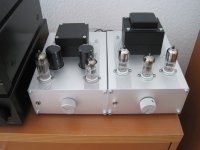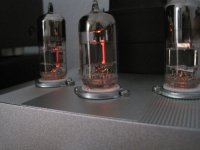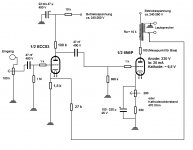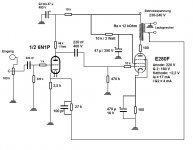Hallo!
After a long time only reading here, I decided to get a member.
Now I introduce you two of my tubeamps. I hope you enjoy reading this. The amps are not “mainstream”, because they partly use tubes, that are not very often used in tubeamps.
I call them “the unequal twins”, because they use the same enclosure. Electrical they are very different.
The first (my first DIY tubeamp) is a triode SE. It uses a ECC83 in the pre- and the ECC99 (or the 6N6P) in the power-stage. The circuit is reduced to the minimum, as you can see on the diagram. In the power-strage you can use the modern ECC99 or the Russian 6N6P. These tubes are not exact similar. They have different bias settings. So I added a potentiometer to the cathode-resistor. So I can switch between them. In my opinion the 6N6P sounds a little bit better. I have tested it with different output-transformers of 7 kOhms and 10 kOhms. The maximum power is a little bit higher with 7 kOhms, but the in my opinion the sound is better with 10 kOhms.
The sound of the amp is like you expect it from triode amp. Very smooth, but not washed. Always precise, wide and deep, never obtrusive or tiring. I can listen to music for hours without getting rid of the amp.
The only negative is the maximum power output. About 1,1 Watt sine. This sounds very low. I use Heco speakers with a efficiency of 92,5 dB. So the power is enough to listen to music in an adequate Volume and feel the bass “in the stomach”.
The second one is a pentode SE. It uses the Russian 6N1P in the pre- and the E280F in the power-stage. I think the 6N1P is meanwhile known as a very good pre- and driver-stage tube. When you read the datasheet, you can see, that it is a real audiotube, made for low frequencies. Nearly everybody knows the 6N23P, they Russian equivalent of the ECC88. In the last years more and more amps use the 6N1P. In my opinion it is a very good audiotube.
The E280F that is used in the power stage is not knows as an audiotube. You can find some circuits, that uses it in triode-connection as a driver tube. Or as a pentode in pre-amps for record-players. When you read the datasheet, you can see, that is a tube build on a very high technical standard. It was developed as a wideband pentode for industrial proposes, used in measuring equipment and other industrial equipment. Long-life cathode (10.000 hours), frame-grid, very low microphonics and very small tolerances. You maybe ask, why I use this tube in a power-stage of an audio-amp? I can give you a very simple answer for this: A good friend of me gave me 4 pieces of it as a present. After consider a while, I decided to build a tube amp with it.
I also use a very simple circuit for the amp. The E280F has a very high transconductance. So there will be a danger of oscillations. You can solve this problem by using very short wire connections. I additionally used ferrite-pills at the anode, G1, G2 connections. The electrical tolerance of the tube is so low, that you do not need a bias-adjust. I have tested 4 tubes and get 4-times the same results.
I like the sound of the amp very much. It is very precise, extremely wide, deep and detailed.
There is also a little bit negative. The power output is about 1,7 Watt sine. As you can read above, this is enough to hear loud music, if you use speakers with an adequate efficiency.
Maybe you ask, which “twin” I like more? You can use both “for every day”. I like a wide spectrum of music. Jazz, rock or things like BigBand sound a little bit better with the “Triode-twin”. Classical-, electrical music or Hard Rock / Heavy Metal things sounds a little bit better with the “pentode”. But this means not, that you can’t listen Jazz with the pentode-amp or the other way.
I hope you enjoy reading this. I'd appreciate feedback.
Kind regards
After a long time only reading here, I decided to get a member.
Now I introduce you two of my tubeamps. I hope you enjoy reading this. The amps are not “mainstream”, because they partly use tubes, that are not very often used in tubeamps.
I call them “the unequal twins”, because they use the same enclosure. Electrical they are very different.
The first (my first DIY tubeamp) is a triode SE. It uses a ECC83 in the pre- and the ECC99 (or the 6N6P) in the power-stage. The circuit is reduced to the minimum, as you can see on the diagram. In the power-strage you can use the modern ECC99 or the Russian 6N6P. These tubes are not exact similar. They have different bias settings. So I added a potentiometer to the cathode-resistor. So I can switch between them. In my opinion the 6N6P sounds a little bit better. I have tested it with different output-transformers of 7 kOhms and 10 kOhms. The maximum power is a little bit higher with 7 kOhms, but the in my opinion the sound is better with 10 kOhms.
The sound of the amp is like you expect it from triode amp. Very smooth, but not washed. Always precise, wide and deep, never obtrusive or tiring. I can listen to music for hours without getting rid of the amp.
The only negative is the maximum power output. About 1,1 Watt sine. This sounds very low. I use Heco speakers with a efficiency of 92,5 dB. So the power is enough to listen to music in an adequate Volume and feel the bass “in the stomach”.
The second one is a pentode SE. It uses the Russian 6N1P in the pre- and the E280F in the power-stage. I think the 6N1P is meanwhile known as a very good pre- and driver-stage tube. When you read the datasheet, you can see, that it is a real audiotube, made for low frequencies. Nearly everybody knows the 6N23P, they Russian equivalent of the ECC88. In the last years more and more amps use the 6N1P. In my opinion it is a very good audiotube.
The E280F that is used in the power stage is not knows as an audiotube. You can find some circuits, that uses it in triode-connection as a driver tube. Or as a pentode in pre-amps for record-players. When you read the datasheet, you can see, that is a tube build on a very high technical standard. It was developed as a wideband pentode for industrial proposes, used in measuring equipment and other industrial equipment. Long-life cathode (10.000 hours), frame-grid, very low microphonics and very small tolerances. You maybe ask, why I use this tube in a power-stage of an audio-amp? I can give you a very simple answer for this: A good friend of me gave me 4 pieces of it as a present. After consider a while, I decided to build a tube amp with it.
I also use a very simple circuit for the amp. The E280F has a very high transconductance. So there will be a danger of oscillations. You can solve this problem by using very short wire connections. I additionally used ferrite-pills at the anode, G1, G2 connections. The electrical tolerance of the tube is so low, that you do not need a bias-adjust. I have tested 4 tubes and get 4-times the same results.
I like the sound of the amp very much. It is very precise, extremely wide, deep and detailed.
There is also a little bit negative. The power output is about 1,7 Watt sine. As you can read above, this is enough to hear loud music, if you use speakers with an adequate efficiency.
Maybe you ask, which “twin” I like more? You can use both “for every day”. I like a wide spectrum of music. Jazz, rock or things like BigBand sound a little bit better with the “Triode-twin”. Classical-, electrical music or Hard Rock / Heavy Metal things sounds a little bit better with the “pentode”. But this means not, that you can’t listen Jazz with the pentode-amp or the other way.
I hope you enjoy reading this. I'd appreciate feedback.
Kind regards
Attachments
What a delight reading this, i very much hope that you continue experimenting
outside the mainline ( by all means build some mainstrem stuff to, comparing
your ideas with some established well-known is never wrong)
I like your open mind. Please continue!
And ,
Frohe Weihnachten
outside the mainline ( by all means build some mainstrem stuff to, comparing
your ideas with some established well-known is never wrong)
I like your open mind. Please continue!
And ,
Frohe Weihnachten
I'd appreciate feedback.
Speaking of which...😀 Your pentode amp looks ripe for an inner feedback loop from the output tube plate to the driver cathode.
There's nothing like building and debugging to make a weekend fun!
Thank you. Good read.
I use the same enclosures on my amps, only shorter. Yours is 20cm while mine is 16cm i think (that sounds awkwardly wrong 😀). I guess we both love compact amps. Where did you get it? How much? Paid around USD12 for it locally.
I use the same enclosures on my amps, only shorter. Yours is 20cm while mine is 16cm i think (that sounds awkwardly wrong 😀). I guess we both love compact amps. Where did you get it? How much? Paid around USD12 for it locally.
Nice read and approach to circuits. I plan on building similar input stages using 6l6/EL34/KT88 output tubes.
Speaking of which...😀 Your pentode amp looks ripe for an inner feedback loop from the output tube plate to the driver cathode.
There's nothing like building and debugging to make a weekend fun!
Hi SY,
wouldn't ouptut plate to driver cathode cause positive feedback?
Hi SY,
wouldn't ouptut plate to driver cathode cause positive feedback?
I think it should be plate to plate
316a
wouldn't ouptut plate to driver cathode cause positive feedback?
I must have entered the twilight zone. Two members, both posting for 12+ years, both having looked at countless tube schematics can't figure out this ridiculously simple circuit?I think it should be plate to plate
Hi SY,
wouldn't ouptut plate to driver cathode cause positive feedback?
Driver cathode is in phase with driver plate. Driver plate is in phase with output tube grid. So.... negative.
Driver cathode is in phase with driver plate. Driver plate is in phase with output tube grid. So.... negative.
I think I got it after some thinking. thanks, erik
Hallo!
Thanks for the positive feedback. I like experimenting outside the mainline.
O.k. I have two other tubeamps that use very common tubes, an EL84 / ECC83 PP, and a PCL86 SE. But these amps also have something “special”. The EL84 PP uses a very old circuit, drawn by an 84 year old electrical engineer. The PCL86 uses a special kind of tube rectification with two PY82 and two solid state diodes.
My momentary project is a solid state amp with germanium transistors. It uses the AD 161/162 in the power stage and the AC153 in the driver stage. The pre-stage uses the BC170, an old silicon, low noise Transistor. Only 3 stages, absolute minimalist. The amp is ready to work, but I have tested it only for a short time. Sounds good, very tube like. But it needs a final setup.
The next tube project will be a triode-connected PL508 amp. Probably in 2017 🙂
I bought the enclosures via Ebay in China. The dimensions are about 15 x 25 cm. I paid about 20 Euro including the cost for shipping apiece. But it is a little bit hard to use such small enclosures. The power transformer of the E280F amp is mounted with a spacer completely above the surface of the enclosure. So I get space for the power supply unit inside the enclosure. It is mounted under the power transformer. My other amps use a bigger enclosure.
I have never tested an inner feedback, because such a kind of feedback does not consider the most nonlinear part of a tubeamp, the output transformer.
It would be nice, if you could explain me why I should use an inner feedback? What would be the advantage of it?
Kind regards, Frank
Thanks for the positive feedback. I like experimenting outside the mainline.
O.k. I have two other tubeamps that use very common tubes, an EL84 / ECC83 PP, and a PCL86 SE. But these amps also have something “special”. The EL84 PP uses a very old circuit, drawn by an 84 year old electrical engineer. The PCL86 uses a special kind of tube rectification with two PY82 and two solid state diodes.
My momentary project is a solid state amp with germanium transistors. It uses the AD 161/162 in the power stage and the AC153 in the driver stage. The pre-stage uses the BC170, an old silicon, low noise Transistor. Only 3 stages, absolute minimalist. The amp is ready to work, but I have tested it only for a short time. Sounds good, very tube like. But it needs a final setup.
The next tube project will be a triode-connected PL508 amp. Probably in 2017 🙂
I bought the enclosures via Ebay in China. The dimensions are about 15 x 25 cm. I paid about 20 Euro including the cost for shipping apiece. But it is a little bit hard to use such small enclosures. The power transformer of the E280F amp is mounted with a spacer completely above the surface of the enclosure. So I get space for the power supply unit inside the enclosure. It is mounted under the power transformer. My other amps use a bigger enclosure.
I have never tested an inner feedback, because such a kind of feedback does not consider the most nonlinear part of a tubeamp, the output transformer.
It would be nice, if you could explain me why I should use an inner feedback? What would be the advantage of it?
Kind regards, Frank
It would be nice, if you could explain me why I should use an inner feedback? What would be the advantage of it?
Lowering the source impedance driving an output transformer lowers the transformer distortion. At the same time, you linearize the amplifier before applying the overall feedback- though it does reduce the overall feedback because of the gain reduction.
not sure if you really need the global fb in triode mode. (unless opt is crap.)Hallo!
i do not😉 (~15k load on 2a3)
Hi Frank,Hallo!
Thanks for the positive feedback. I like experimenting outside the mainline.
O.k. I have two other tubeamps that use very common tubes, an EL84 / ECC83 PP, and a PCL86 SE. But these amps also have something “special”. The EL84 PP uses a very old circuit, drawn by an 84 year old electrical engineer. The PCL86 uses a special kind of tube rectification with two PY82 and two solid state diodes.
My momentary project is a solid state amp with germanium transistors. It uses the AD 161/162 in the power stage and the AC153 in the driver stage. The pre-stage uses the BC170, an old silicon, low noise Transistor. Only 3 stages, absolute minimalist. The amp is ready to work, but I have tested it only for a short time. Sounds good, very tube like. But it needs a final setup.
The next tube project will be a triode-connected PL508 amp. Probably in 2017 🙂
I bought the enclosures via Ebay in China. The dimensions are about 15 x 25 cm. I paid about 20 Euro including the cost for shipping apiece. But it is a little bit hard to use such small enclosures. The power transformer of the E280F amp is mounted with a spacer completely above the surface of the enclosure. So I get space for the power supply unit inside the enclosure. It is mounted under the power transformer. My other amps use a bigger enclosure.
I have never tested an inner feedback, because such a kind of feedback does not consider the most nonlinear part of a tubeamp, the output transformer.
It would be nice, if you could explain me why I should use an inner feedback? What would be the advantage of it?
Kind regards, Frank
I also made a "normal" Ge amp (I posted about them in other topic). I used AD161/162, 2SD352 or AC187 in driver and 2SB486 Ge at input, a sleeper low noise Ge transistor (3dB NF in old manuais/datasheet; in same manual most silicon transistors have more than that "Noise Figure" value), but is almost unobtanium now. In fact I measured lower noise than using some silicon in these place, like BC179 or BCY79. My PSU is positive, so this put the NPN driver into "ground rail" and this betters a lot the amp PSRR.
The sound is better than most people presumes about!
http://www.diyaudio.com/forums/solid-state/220222-nognfb-integrated-amp-ge-transistors-output-2.html
See posts 11, 15 and 18 for more comments.
- Status
- Not open for further replies.
- Home
- Amplifiers
- Tubes / Valves
- "The unequal twins" ECC83 / ECC99 Triode and 6N1P / E280F pentode amps



